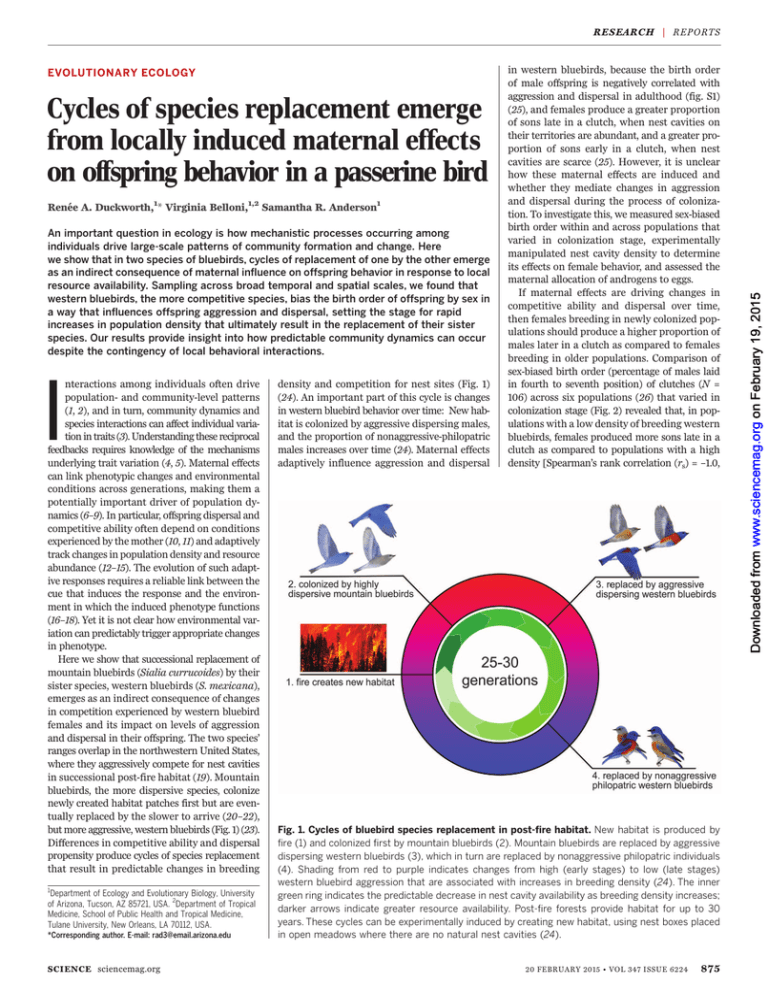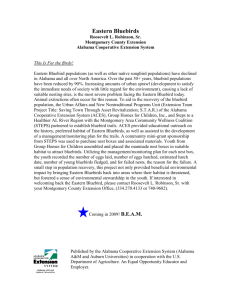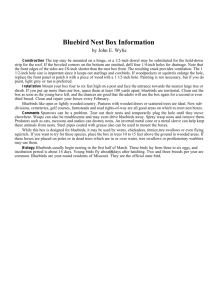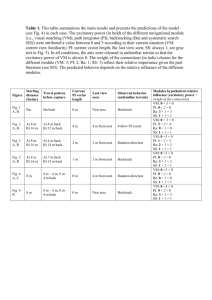
EVOLUTIONARY ECOLOGY
Cycles of species replacement emerge
from locally induced maternal effects
on offspring behavior in a passerine bird
Renée A. Duckworth,1* Virginia Belloni,1,2 Samantha R. Anderson1
An important question in ecology is how mechanistic processes occurring among
individuals drive large-scale patterns of community formation and change. Here
we show that in two species of bluebirds, cycles of replacement of one by the other emerge
as an indirect consequence of maternal influence on offspring behavior in response to local
resource availability. Sampling across broad temporal and spatial scales, we found that
western bluebirds, the more competitive species, bias the birth order of offspring by sex in
a way that influences offspring aggression and dispersal, setting the stage for rapid
increases in population density that ultimately result in the replacement of their sister
species. Our results provide insight into how predictable community dynamics can occur
despite the contingency of local behavioral interactions.
I
nteractions among individuals often drive
population- and community-level patterns
(1, 2), and in turn, community dynamics and
species interactions can affect individual variation in traits (3). Understanding these reciprocal
feedbacks requires knowledge of the mechanisms
underlying trait variation (4, 5). Maternal effects
can link phenotypic changes and environmental
conditions across generations, making them a
potentially important driver of population dynamics (6–9). In particular, offspring dispersal and
competitive ability often depend on conditions
experienced by the mother (10, 11) and adaptively
track changes in population density and resource
abundance (12–15). The evolution of such adaptive responses requires a reliable link between the
cue that induces the response and the environment in which the induced phenotype functions
(16–18). Yet it is not clear how environmental variation can predictably trigger appropriate changes
in phenotype.
Here we show that successional replacement of
mountain bluebirds (Sialia currucoides) by their
sister species, western bluebirds (S. mexicana),
emerges as an indirect consequence of changes
in competition experienced by western bluebird
females and its impact on levels of aggression
and dispersal in their offspring. The two species’
ranges overlap in the northwestern United States,
where they aggressively compete for nest cavities
in successional post-fire habitat (19). Mountain
bluebirds, the more dispersive species, colonize
newly created habitat patches first but are eventually replaced by the slower to arrive (20–22),
but more aggressive, western bluebirds (Fig. 1) (23).
Differences in competitive ability and dispersal
propensity produce cycles of species replacement
that result in predictable changes in breeding
1
Department of Ecology and Evolutionary Biology, University
of Arizona, Tucson, AZ 85721, USA. 2Department of Tropical
Medicine, School of Public Health and Tropical Medicine,
Tulane University, New Orleans, LA 70112, USA.
*Corresponding author. E-mail: rad3@email.arizona.edu
SCIENCE sciencemag.org
density and competition for nest sites (Fig. 1)
(24). An important part of this cycle is changes
in western bluebird behavior over time: New habitat is colonized by aggressive dispersing males,
and the proportion of nonaggressive-philopatric
males increases over time (24). Maternal effects
adaptively influence aggression and dispersal
in western bluebirds, because the birth order
of male offspring is negatively correlated with
aggression and dispersal in adulthood (fig. S1)
(25), and females produce a greater proportion
of sons late in a clutch, when nest cavities on
their territories are abundant, and a greater proportion of sons early in a clutch, when nest
cavities are scarce (25). However, it is unclear
how these maternal effects are induced and
whether they mediate changes in aggression
and dispersal during the process of colonization. To investigate this, we measured sex-biased
birth order within and across populations that
varied in colonization stage, experimentally
manipulated nest cavity density to determine
its effects on female behavior, and assessed the
maternal allocation of androgens to eggs.
If maternal effects are driving changes in
competitive ability and dispersal over time,
then females breeding in newly colonized populations should produce a higher proportion of
males later in a clutch as compared to females
breeding in older populations. Comparison of
sex-biased birth order (percentage of males laid
in fourth to seventh position) of clutches (N =
106) across six populations (26) that varied in
colonization stage (Fig. 2) revealed that, in populations with a low density of breeding western
bluebirds, females produced more sons late in a
clutch as compared to populations with a high
density [Spearman’s rank correlation (rs) = –1.0,
Fig. 1. Cycles of bluebird species replacement in post-fire habitat. New habitat is produced by
fire (1) and colonized first by mountain bluebirds (2). Mountain bluebirds are replaced by aggressive
dispersing western bluebirds (3), which in turn are replaced by nonaggressive philopatric individuals
(4). Shading from red to purple indicates changes from high (early stages) to low (late stages)
western bluebird aggression that are associated with increases in breeding density (24). The inner
green ring indicates the predictable decrease in nest cavity availability as breeding density increases;
darker arrows indicate greater resource availability. Post-fire forests provide habitat for up to 30
years. These cycles can be experimentally induced by creating new habitat, using nest boxes placed
in open meadows where there are no natural nest cavities (24).
20 FEBRUARY 2015 • VOL 347 ISSUE 6224
875
Downloaded from www.sciencemag.org on February 19, 2015
RE S EAR CH | R E P O R T S
R ES E A RC H | R E PO R TS
P < 0.01; Fig. 3A]. Across populations, the breeding
density of western bluebirds was negatively correlated with the proportion of breeding mountain bluebird pairs (rs = –0.83, P = 0.04), leading
to a positive correlation between sex-biased birth
order and mountain bluebird presence (rs = 0.82,
P < 0.02; Fig. 3A).
From among-population patterns, the cue
that induces females to modify sex-biased birth
order is unclear because multiple factors vary
with population age. To disentangle these factors,
we measured sex-biased birth order over 10 years
in a population from which mountain bluebirds
had already been excluded (26). At this site, the
typical association of nest cavity availability and
breeding density was reversed through the addition of nest boxes (fig. S2). Whereas under
natural conditions the number of available nest
Fig. 2. Colonization stages of study populations in western Montana. The shading of the outer
circle shows the start of new habitat (nest box symbol) and the population’s current cycle stage
(Fig. 1). Red lines transecting the outer ring indicate sampling time. The text in a circle shows
population name (OVD, UMC, PAU, WWH, MTJ, and STR), sample size, and time since western
bluebirds’ colonization.
cavities decreases as western bluebird population density increases, we increased nest cavity
availability as western bluebird density increased
(fig. S2). In contrast to the among-population
pattern, in years of high conspecific density,
females produced a higher proportion of sons
late in a clutch [F = 8.54, standardized regression
coefficient (bST) = 0.72, P = 0.01, n = 10 years, 190
nests]. However, this correlation was driven by
an association of nest box density and sexbiased birth order (F = 24.59, bST = 0.89, P =
0.001; Fig. 3B): In years of high nest box density,
females produced more sons late in a clutch,
making nest box density a better predictor of
sex-biased birth order (t = 5.21, bST = 1.25, P =
0.001) than conspecific density [t statistic (t) =
–1.54, bST = –0.36, P = 0.17]. These patterns suggest that cues related to nest cavity availability,
rather than the number of bluebirds in an area,
induce the maternal effect.
How could the simple presence of unoccupied
nest cavities trigger the adaptive adjustment of
offspring phenotype? Western and mountain
bluebirds defend exclusive territories, and the
majority of competitive interactions among bluebirds occur in March and April, well before the
onset of oogenesis, making them rare during
the period when effects on sex-biased birth order are most likely (fig. S3). However, bluebirds
defend their primary cavity throughout the
breeding period from other species, and the
peak of these non-bluebird intrusions overlaps
with oogenesis (fig. S3). Thus, we hypothesized
that females on territories with extra nest cavities experience differential competition from
non-bluebird nest site competitors.
We tested this by experimentally creating territories of high and low nest cavity availability
and recording female behavior during oogenesis
(26). Females breeding on territories where nest
cavity abundance was increased experienced fewer
attempted takeovers of their primary nest cavity
by competitors (0.65 T 0.11/hour) than females
Fig. 3. Among- and within-population variation in sex-biased birth order. (A) Sex-biased birth order (bars with standard errors) was negatively correlated
with conspecific density (dotted line) and positively correlated with the presence of mountain bluebirds (pie charts). Dark and light blue indicate the percent of
territories occupied by mountain and western bluebirds, respectively. (B) In years of high nest cavity density, in which nest sites were abundant, females
produced sons later in the clutch as compared to years of low nest cavity density (n = 10 years).
876
20 FEBRUARY 2015 • VOL 347 ISSUE 6224
sciencemag.org SCIENCE
RE S EAR CH | R E P O R T S
Fig. 4. Androgen allocation to a clutch is a key link between sex-biased birth order and resource availability. (A) Mean androgen levels were
positively related to the distance to the nearest unoccupied nest cavity. The hatched area indicates distances within a typical bluebird territory. (B) Clutches in
which females produced sons late in the birth order contained less androgen than did clutches in which females produced sons early. Shown are 95% confidence
intervals.
on control territories, which had only a single
nest cavity (1.75 T 0.42/hour; t52 = –2.50, P < 0.02).
Intrusion rates of competitor species and female
aggressive response rates were correlated (r =
0.90, P < 0.0001), so that females on multicavity
territories engaged in fewer aggressive interactions (0.73 T 0.15/hour) than did females on
single-cavity territories (1.70 T 0.42/hour, t52 = –2.17,
P < 0.05). In vertebrates, engaging in aggressive
interactions influences physiology, such as the concentration of circulating steroid hormones (27, 28),
which can influence both sex-biased birth order and maternal allocation of hormones to eggs
(29, 30).
To determine whether variation in the local
competitive environment influenced females’
deposition of hormones in eggs, we used enzyme immunoassays to measure yolk androgens
(26)—which are known to have both short- and
long-term effects on offspring competitive behavior (31, 32)—from 20 clutches of eggs collected from a population in which nest cavity
density was highly variable. Androgen allocation to eggs differed significantly among clutches
(fig S4), and females with extra nest cavities
allocated less androgen to their clutches than did
females without extra nest cavities on their territories (F = 9.04, bST = 0.58, P < 0.01; Fig. 4A). To
determine whether androgen variation among
clutches was linked to sex-biased birth order,
we biopsied yolk samples from 15 additional
clutches, allowed offspring to develop normally,
and determined their sex (26). Clutches with a
higher percentage of males early had higher
androgen levels than clutches with a higher
percentage of males in later positions (rs = –0.54,
P < 0.05, n = 15 clutches; Fig. 4B). These results
suggest that hormone allocation to egg yolk is a
key link between resource abundance, sex-biased
birth order, and changes in offspring behavior.
Maternally induced variation in western bluebird behavior ultimately results in the displaceSCIENCE sciencemag.org
ment of mountain bluebirds, as females from
crowded populations produce aggressive sons
that colonize new areas. However, the cue that
induces the maternal effect has no direct connection to this larger-scale pattern. Instead, the
process of colonization itself sets the stage for rapid
changes in aggression over time. By dominating
mountain bluebirds and acquiring large resourcerich territories (19), the colonizing generation
creates the environment that induces rapid changes
in offspring aggression and population growth.
As habitat patches become crowded, females then
produce aggressive sons, which disperse and colonize new areas, restarting the cycle. The extreme
limitation of nest cavities for secondary cavitynesting species means that there will always be
competitor species intruding on bluebird territories, making competitive interactions over nest
sites a reliable cue of the availability of parental
resources. Thus, our results provide insight into
how predictable community dynamics can occur
despite the contingent nature of local-scale behavioral interactions.
RE FERENCES AND NOTES
1. S. A. Levin, Ecology 73, 1943–1967 (1992).
2. M. A. Leibold et al., Ecol. Lett. 7, 601–613 (2004).
3. L. Ginzburg, M. Colyvan, Ecological Orbits: How Planets
Move and Populations Grow (Oxford Univ. Press, New York,
2004).
4. E. E. Werner, Am. Nat. 140, S5–S32 (1992).
5. D. E. Bowler, T. G. Benton, Biol. Rev. Camb. Philos. Soc. 80,
205–225 (2005).
6. A. V. Badyaev, R. L. Young, G. E. Hill, R. A. Duckworth, J. Evol.
Biol. 21, 449–460 (2008).
7. M. Rossiter, Annu. Rev. Ecol. Syst. 27, 451–476
(1996).
8. J. Bernardo, Am. Zool. 36, 83–105 (1996).
9. L. R. Ginzburg, D. E. Taneyhill, J. Anim. Ecol. 63, 79–92
(1994).
10. A. J. Zera, R. F. Denno, Annu. Rev. Entomol. 42, 207–230
(1997).
11. M. Massot, J. Clobert, J. Evol. Biol. 13, 707–719
(2000).
12. K. Donohue, Am. Nat. 154, 674–689 (1999).
13. R. F. Denno, G. K. Roderick, K. L. Olmstead, H. Döbel, Am. Nat.
138, 1513–1541 (1991).
14. R. G. Harrison, Annu. Rev. Ecol. Syst. 11, 95–118 (1980).
15. B. Dantzer et al., Science 340, 1215–1217 (2013).
16. T. J. DeWitt, A. Sih, D. S. Wilson, Trends Ecol. Evol. 13, 77–81
(1998).
17. T. Getty, Am. Nat. 148, 378–385 (1996).
18. A. V. Badyaev, T. Uller, Philos. Trans. R. Soc. London Ser. B
364, 1169–1177 (2009).
19. R. A. Duckworth, in Avian Urban Ecology: Behavioural and
Physiological Adaptations, D. Gil, H. Brumm, Eds. (Oxford Univ.
Press, Oxford, 2013), pp. 181–191.
20. R. L. Hutto, Conserv. Biol. 9, 1041–1058 (1995).
21. N. B. Kotliar, P. L. Kennedy, K. Ferree, Ecol. Appl. 17, 491–507
(2007).
22. V. A. Saab, R. E. Russell, J. G. Dudley, Condor 109, 97–108
(2007).
23. R. A. Duckworth, A. V. Badyaev, Proc. Natl. Acad. Sci. U.S.A.
104, 15017–15022 (2007).
24. R. A. Duckworth, Am. Nat. 172, S4–S17 (2008).
25. R. A. Duckworth, Philos. Trans. R. Soc. London Ser. B 364,
1075–1086 (2009).
26. Materials and methods available as supplementary materials
on Science Online.
27. J. C. Wingfield, Horm. Behav. 48, 253–255, discussion
256–258 (2005).
28. B. Silverin, Anim. Behav. 56, 811–818 (1998).
29. O. P. Love, E. H. Chin, K. E. Wynne-Edwards, T. D. Williams,
Am. Nat. 166, 751–766 (2005).
30. T. W. Pike, M. Petrie, Biol. Rev. Camb. Philos. Soc. 78,
553–574 (2003).
31. H. Schwabl, Proc. Natl. Acad. Sci. U.S.A. 90, 11446–11450
(1993).
32. C. M. Eising, W. Müller, T. G. Groothuis, Biol. Lett. 2, 20–22
(2006).
AC KNOWLED GME NTS
We thank Mountain Bluebird Trails members for access to trails.
A. Badyaev, D. Higginson, C. Gurguis, E. Morrison, S. Aguillon,
J. Padway, and two anonymous reviewers provided helpful
comments on a draft of this manuscript. This work was funded
by NSF (grant DEB-918095). Data are available in the
supplementary materials.
SUPPLEMENTARY MATERIALS
www.sciencemag.org/content/347/6224/875/suppl/DC1
Materials and Methods
Figs. S1 to S5
References (33–44)
19 August 2014; accepted 16 January 2015
10.1126/science.1260154
20 FEBRUARY 2015 • VOL 347 ISSUE 6224
877
Cycles of species replacement emerge from locally induced maternal
effects on offspring behavior in a passerine bird
Renée A. Duckworth et al.
Science 347, 875 (2015);
DOI: 10.1126/science.1260154
This copy is for your personal, non-commercial use only.
If you wish to distribute this article to others, you can order high-quality copies for your
colleagues, clients, or customers by clicking here.
The following resources related to this article are available online at
www.sciencemag.org (this information is current as of February 19, 2015 ):
Updated information and services, including high-resolution figures, can be found in the online
version of this article at:
http://www.sciencemag.org/content/347/6224/875.full.html
Supporting Online Material can be found at:
http://www.sciencemag.org/content/suppl/2015/02/18/347.6224.875.DC1.html
A list of selected additional articles on the Science Web sites related to this article can be
found at:
http://www.sciencemag.org/content/347/6224/875.full.html#related
This article cites 38 articles, 9 of which can be accessed free:
http://www.sciencemag.org/content/347/6224/875.full.html#ref-list-1
This article has been cited by 1 articles hosted by HighWire Press; see:
http://www.sciencemag.org/content/347/6224/875.full.html#related-urls
This article appears in the following subject collections:
Ecology
http://www.sciencemag.org/cgi/collection/ecology
Science (print ISSN 0036-8075; online ISSN 1095-9203) is published weekly, except the last week in December, by the
American Association for the Advancement of Science, 1200 New York Avenue NW, Washington, DC 20005. Copyright
2015 by the American Association for the Advancement of Science; all rights reserved. The title Science is a
registered trademark of AAAS.
Downloaded from www.sciencemag.org on February 19, 2015
Permission to republish or repurpose articles or portions of articles can be obtained by
following the guidelines here.








